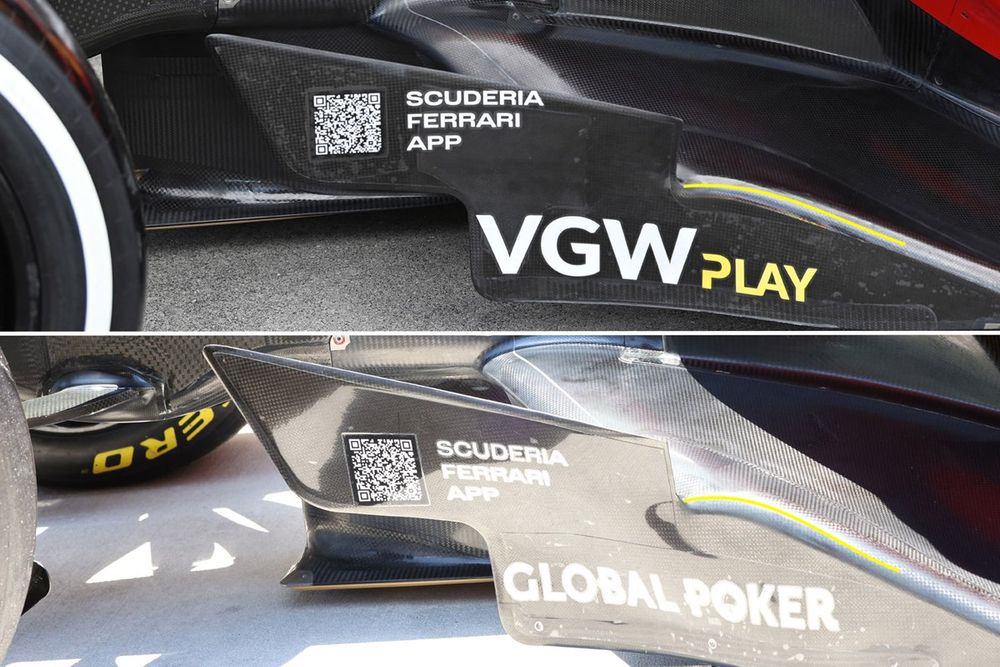
A case in point was spotted in Miami last weekend as both Mercedes and Williams took to free practice with different configurations mounted on their cars.

For Mercedes, this resulted in Lewis Hamilton running with an infill panel for the upper tip section of the rear wing endplate. Meanwhile, George Russell utilised a more conventional cut-out.
This design difference has a marked effect on the behaviour of the outer section of the wing, with drag and downforce levels traded off against one another.
This sort of experimentation is helped by Mercedes' decision to produce a rear wing that has interchangeable parts, which not only saves money in terms of manufacturing but also allows for quick aerodynamic setup changes too (red arrow).
Meanwhile, at the front of the car, Mercedes trimmed the inboard trailing edge of the upper flap in a crescent shape to help reduce downforce and balance the car with its choices at the rear of the car (blue arrow).
This is a solution that we first saw from Alpine in Azerbaijan, as it also looked to find the right balance front-to-rear.
For qualifying and the race, Hamilton continued with the arrangement seen above, while Russell made the switch to the front wing with the cut-out but retained the rear wing tip cut-out.
More, or less?

Williams was also experimenting with its aerodynamic setup during free practice, as it looked at ways to trade performance between the upper rear wing elements and the beam wing.
Alex Albon was tasked with trialling the higher downforce rear wing arrangement with just a single lower beam wing element, while Logan Sargeant ran laps with the lower downforce rear wing, which was married to a double beam wing set-up.
In the end, Sargeant switched out to the same arrangement as Albon, as the team leaned on more performance from the rear wing, while improving its straightline speed with the single beam wing element.
Cooling off period…

Aston Martin added another cooling option in the engine cover panel to help deal with the demands of the Miami street circuit.
The team has various options available, including bodywork panels where the louvres are pitched more open and closed, while longer and shorter blanking panels are also possible in order to help trade cooling/heat rejection for aerodynamic efficiency and vice versa.

Meanwhile, Red Bull has taken to running with an asymmetric cooling configuration on the RB19 this season, with the team once again opting for the louvred cooling panel to be used on just the right-hand side of the car in Miami (red arrow).
It also toyed with a couple of options for more or less cooling during free practice, before settling on the more expansive option for the race and qualifying (lower, larger inset).

Ferrari is set to introduce a raft of new parts for the SF-23 in the upcoming races, as it looks to close the gap to Red Bull ahead of it.
It kicked this off in Miami as a new floor arrived that featured numerous changes up and down the assembly to provide a performance boost across the spectrum, rather than just providing a singular focus.
The outer front section of the floor and the shape of the outer fence have been modified, with a more pronounced bulge present in the forward section of the downward ramp section of the floor (see yellow highlights), while the shape and height of the trailing edge of the floor fence ahead of it has also been altered as a consequence.
The change in curvature will have an impact on the airflow's behaviour on the top surface but, perhaps more critically, it will change the available pocket of space in the underfloor beneath, with the shape of the floor fences also likely optimised in order to further enhance the effect.

There also appear to have been some subtle changes to the various surface contours used on the floor's edge, with the upwardly rolled scroll section and the section that tapers toward the rear tyre both subtly different in Miami.
There were also changes in the diffuser, as the team modified the shape of the central boat tail section, in order to take advantage of the advancements made ahead of it.








